Techniques for countering fake news in regional society: what strengthens trust in the post-truth era?
Relevance. The article is devoted to studying the role and extent of the spread of fakes in modern society. They are interpreted as a threat to the security of the information space. In addition, the focus of the study is on the practices of identifying this kind of destructive content, considered at the legal, contextual and technological levels. Scientific problem. Countering false information seems important in the context of military and information confrontation between Russia and the collective West. It is emphasized that the consequences of the influence of fakes on individuals can be prolonged over time, largely mediated by their development of critical thinking and information hygiene. Methods. The empirical basis of this study was the results of a mass representative sociological survey conducted by the author in April-May 2024 among the population of the Republic of Mordovia (n=1,000). In addition, they were supplemented with measurement data from the Scientific Center for Socio-Economic Monitoring, carried out in the same region using a similar methodology, but with a smaller sample size (n=374). The article pays special attention to the data obtained through open-ended questions, which were codified and formed the basis for countering fake news. Research results. The results obtained during the study allow us to conclude that there is a high level of awareness of the population about fakes. This indirectly confirms the significance of their perception in the public consciousness. It was also revealed that every second person surveyed had been exposed to this kind of destructive content over the past month. At the same time, three out of ten respondents over the past year have believed false information at least once, and two out of ten shared it with their immediate circle. Information hygiene practices can be assessed as relatively undeveloped; only one in seven regularly evaluates incoming information before telling their friends, acquaintances or relatives about it. Conclusions. Based on the respondents’ experience in detecting fake news, three main techniques were identified that allow one to distinguish false information from reliable information: firstly, it is necessary to evaluate the source where this or that content was posted – is it authoritative and of high quality; secondly, it is necessary to search for it in other sources, primarily official ones – if this is not stated anywhere, then there is a high probability that the information received is unreliable; thirdly, it is important to try to determine whether the authors publish their material in a neutral context, or are trying to evoke emotions in the audience, and in some cases, even simulate affective actions – in this case, the facts, not the presentation of the material, become fundamentally significant.
Figures
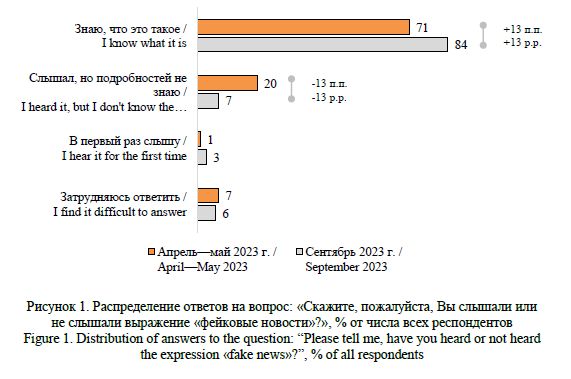
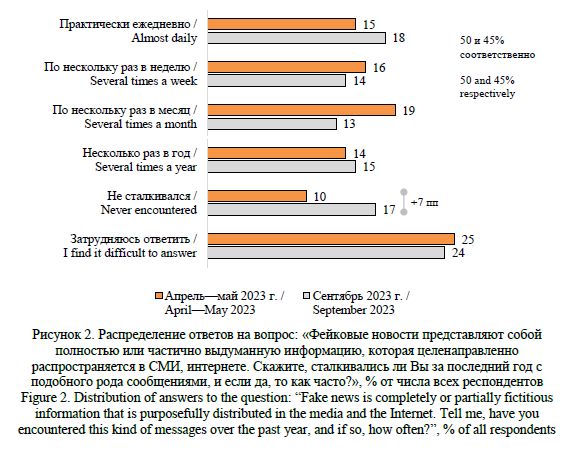
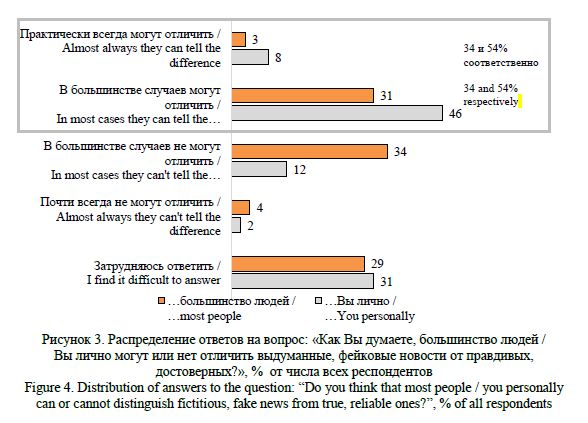
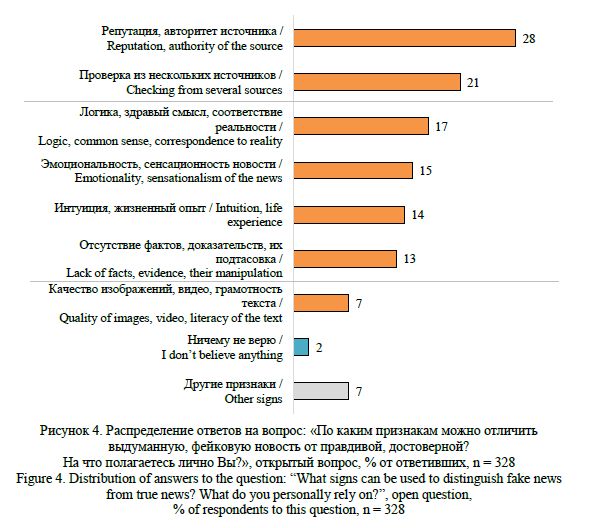
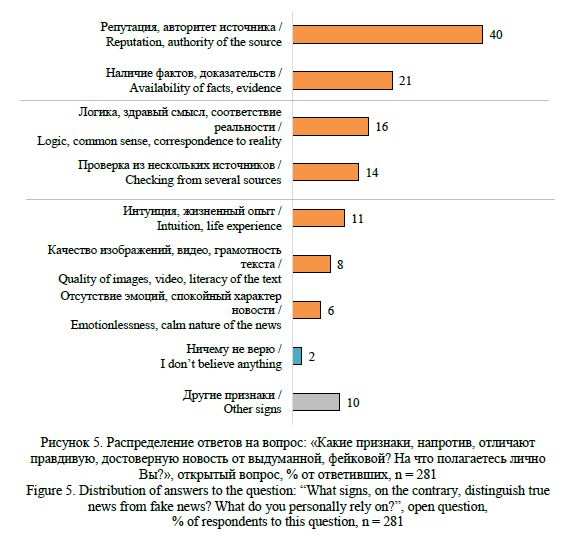
Ushkin, S. G. (2025), “Techniques for countering fake news in regional society: what strengthens trust in the post-truth era?”, Research Result. Sociology and Management, 11 (1), 246-261, DOI: 10.18413/2408-9338-2025-11-1-1-6.


















While nobody left any comments to this publication.
You can be first.
Bergstrom, C., West, J. (2022), Polny bred! Skeptitsizm v mire bolshih dannyh [Calling bullshit: the art of skepticism in a data-driven world], Mann, Ivanov and Ferber, Moscow, Russia. (In Russian)
Bogoslovskaya, V. R., Sharkov, F. I. (2021), “The phenomenon of fake news: a review of recent research”, Kommunikologiya: elektronny nauchny zhurnal, 6(3), 111-118. (In Russian)
Ilchenko, S. N. (2015), “Fake as a political format in modern media environment, Gumanitarny vektor, (3), 98-101. (In Russian)
Kazakov, A.A. (2017), “Media literacy within the context of political culture: revisiting the definition of the term”, Vestnik Moskovskogo universiteta. Seriya 10. Zhurnalistika, (4), 78-97. (In Russian)
Mikhailova, E. A. (2023), “Trust, distrust and fake news in the process of political legitimization”, Izvestiya Saratovskogo universiteta. Novaya seriya. Seriya: Sotsiologiya. Politologiya, 23(2), 227-234, DOI: 10.18500/1818-9601-2023-23-2-227-234. (In Russian)
Onufrienko, A. A. (2023), “Procedures of struggle against a fake news. experience of the west2, Svobodnaya mysl, (2), 159-175. (In Russian)
Puzanova, Zh. V., Filippov, V. M., Larina, T. I., Simonova, M. A. (2023), “On the study of factors of fake news perception by mass audience (case study of student youth)”, Vestnik Instituta Sotsiologii, 14 (4), 128-146, DOI: 10.19181/vis.2023.14.4.8. (In Russian)
Habermas, J. A. (2023), Novaya strukturnaya transformatsiya publichnoy sfery i deliberativnaya politika [New structural transformation of the public sphere and deliberative politics], New literary review, Moscow, Russia, 104. (In Russian)
Iakoba, I. A. (2023), “The constructed and the real in mediatization: interpretation of the Second World War by the West and Russia, Vestnik Instituta Sotsiologii, 14 (4), 93-111, DOI: 10.19181/vis.2023.14.4.6. (In Russian)
Aïmeur, E., Amri, S., Brassard, G. (2023), “Fake news, disinformation and misinformation in social media: a review”, Social Network Analysis and Mining, 13 (3), 13-30, DOI: 10.1007/s13278-023-01028-5.
Allcott, H., Gentzkow, M. (2017), “Social media and fake news in the 2016 Election”, The Journal of Economic Perspectives, 31 (2), 211-235, DOI: 10.1257/jep.31.2.211.
Baptista, J. P., Gradim, A. (2020), “Understanding Fake News Consumption: A Review”, Social Sciences, 9 (10), 185, DOI: 10.3390/socsci9100185.
Edgerly, S., Mourão, R. R., Thorson, E., Tham, S. M. (2020), “When Do Audiences Verify? How Perceptions About Message and Source Influence Audience Verification of News Headlines”, Journalism & Mass Communication Quarterly, 97 (1), 52-71, DOI: 10.1177/1077699019864680.
Flynn, D. J., Nyhan, B., & Reifler, J. (2017), “The nature and origins of misperceptions: Understanding false and unsupported beliefs about politics”, Political Psychology, 38 (S1), 127-150, DOI: 10.1111/pops.12394
Grinberg, N., Joseph, K., Friedland, L., Swire-Thompson, B., Lazer, D. (2019), “Fake news on Twitter during the 2016 U.S. presidential election”, Science, 363 (6425), 374-378. DOI:10.1126/science.aau2706.
Guess, A., Nagler, J., Tucker, J. (2019), “Less than you think: Prevalence and predictors of fake news dissemination on Facebook”, Science Advances, 5 (1), DOI: 10.1126/sciadv.aau4586.
Guess, A. M, Lerner, M., Lyons, B., Montgomery, J. M., Nyhan, B., Reifler, J., Sircar, N. (2020), “A digital media literacy intervention increases discernment between mainstream and false news in the United States and India”, PNAS, 117 (27), 15536-15545, DOI: 10.1073/pnas.1920498117.
Lazer, D. M., Baum, M. A., Benkler, Y., Berinsky, A. J., Greenhill, K. M., Menczer, F., Metzger, M. J., Nyhan, B., Pennycook, G., Rothschild, D. M., Schudson, M., Sloman, S. A., Sunstein, C. R., Thorson, E. A., Watts, D. J., Zittrain, J. (2018), “The science of fake news”, Science, 359(6380), 1094-1096, DOI: 10.1126/science.aao2998.
Mercier, H., Boudry, M., Paglieri, F., Trouche, E. (2017), “Natural-Born Arguers: Teaching How to Make the Best of Our Reasoning Abilities”, Educational Psychologist, 52 (1), 1-16, DOI: 10.1080/00461520.2016.1207537.
Metzger, M. J., Hartsell, E. H., Flanagin, A. J. (2020), “Cognitive Dissonance or Credibility? A Comparison of Two Theoretical Explanations for Selective Exposure to Partisan News”, Communication Research, 47 (1), 3-28, DOI: 10.1177/0093650215613136.
Olan, F., Yayawickrama, U., Arakpogun, E. O. Suklan, J., Liu, Sh. (2022), Fake News on Social Media: the Impact on Society, Information Systems Frontiers, DOI: 10.1007/s10796-022-10242-z.
Vosoughi, S., Roy, D., Aral, S. (2018), “The spread of true and false news online”, Science, 359(6380), 1146-1151, DOI: 10.1126/science.aap9559.
The work was prepared within the framework of the grant of the Russian Science Foundation No. 227800082, https://rscf.ru/project/22-78-00082 /. The author expresses gratitude to the Administration of the Head of the Republic of Mordovia and the Government of the Republic of Mordovia, the National Research Mordovian State University and the Scientific Center for Socio-Economic Monitoring for their assistance in organizing the field stage of the study.